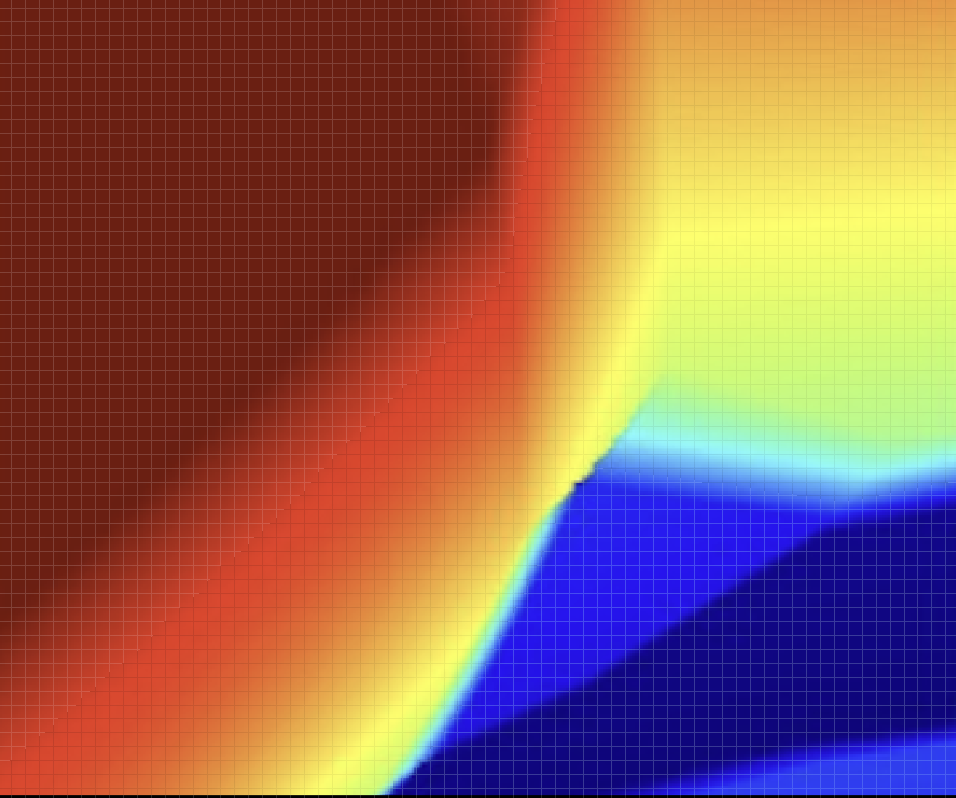

High Performance Computing Physics-Based solution for modelling of multicomponent fluid flow within deforming and reactive host rocks unique to
ReactMod's capabilities are showcased through a series of case studies, including successful reproduction of natural carbonation at outcrop scale and gas chimney formation at basin scale.
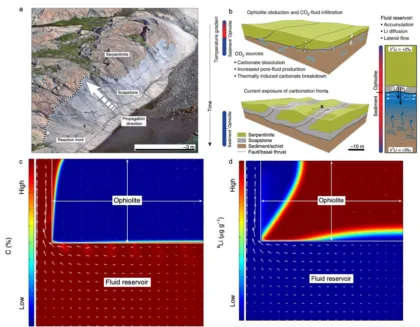
Ophiolite alteration and simulated fluid reservoir compositional evolution a) Representative outcrop image of a ~3 m wide soapstone alteration selvage around a fracture in serpentinite.b) Schematic depicting ophiolite emplacement onto metasediments, alteration fluid accumulation below the basal ophiolite thrust and soapstone formation along the thrust and fluid conduits. c) Fluid carbon concentrations and flow vectors in 2D. Beneath the basal thrust, flow is predominantly horizontal and drains the top section of the fluid reservoir into the ophiolite-hosted vertical fracture. Fluid density gradients result in deviation from a purely horizontal flow. d) Fluid 6Li concentrations in 2D, showing that mineral replacement lags behind the fluid 6Li front.
(Beinlich, A., John, T., Vrijmoed, J. C., Tominaga, M., Magna, T., & Podladchikov, Y. Y., Nature Geoscience, 2020)
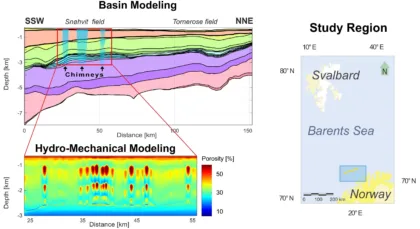
Numerical simulation of chimney formation and propagation through lithological boundaries in two fields in the SW Barents Sea, the Tornerose field and the Snøhvit field in the Hammerfest Basin. Multi-layer basin models is used to produce the initial conditions for the hydro-mechanical modelling. (Peshkov, G. A., Khakimova, L. A., Grishko, E. V., Wangen, M., &Yarushina, V. M., Energies, 2021)
ReactMod’s capabilities are currently utilized to replicate CO2 mineralization experiments during CO2 injection into basalt formations.
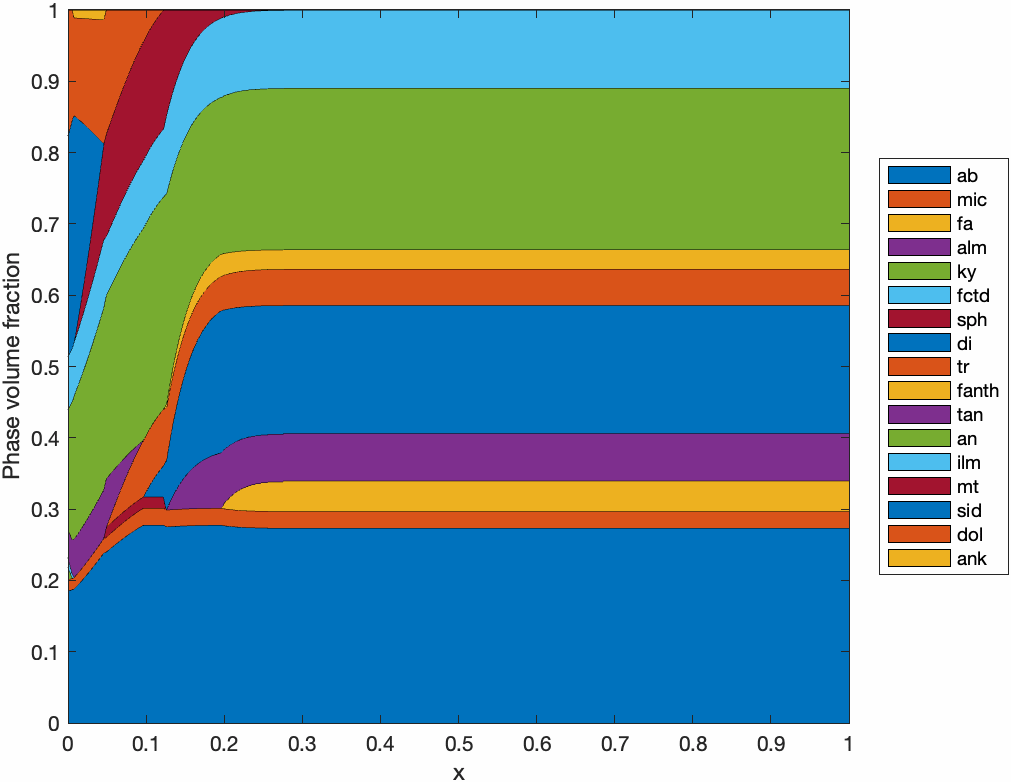
CO2 mineralisation during CCS -- numerical simulation illustrating the formation of siderite during CO2 injection into basalts (Deccan Trap), achieved through a coupled transport model and thermodynamic calculations that process over a hundred potential mineral phases under specific conditions
High Performance Computing
Harnesses cutting-edge acceleratednumerical algorithms and GPU-optimized solvers to deliver fast,precision-driven simulations
Genuine Internal Coupling
Seamlessly integrates multicomponent fluid flow, deformation, and reactions for unprecedented simulation fidelity
High-Speed Multicomponent Processing
Executes simultaneouscalculations for over 200 minerals and species, delivering unparalleled insightinto complex chemical interactions in real-time
Precision-Crafted for Localized Effects
Capturesevents with extreme localization in time and space -- from seconds to years, and from centimeters to kilometers
Dynamic Pore Space Evolution
Accurately models the continuous transformation of pore structures under varying conditions
Breakthrough Reproducibility
Successfully replicates recently investigated phenomena, including gas chimneys, (de)carbonation, and (de)hydration processes even in zero-permeability rocks, …
Advanced computing for capturing localized effects in space and time
ReactMod performs based on accelerated numerical algorithms effectively emerged with GPU-optimized solvers which captures events with extreme localization in time and space: from seconds to years, from centimeters to kilometers (Räss et al., Geosc. Mod. Dev., 2022; Alkhimenkov & Podladchikov, Geosc. Mod. Dev. Discus., 2024 )
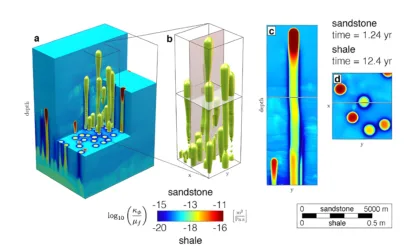
High-resolution numerical simulations, performed at 80 NVIDIA GeForce GTX TITAN X GPUs (Maxwell GM200 architecture) of the Octopus cluster at the University of Lausanne (Switzerland) within domain of 500 × 500 × 1000 grid points: high-permeability chimney genesis out of a source region (reservoir) in 3D. Color plot (logarithmic scale) of dynamic permeability for sandstone and shale lithology. (a) Insight into the hydro-mechanical model unveiling the existence of high-permeability chimneys as tubular shaped features in three dimensions. (b) Enlargement of the center of the model, selectively displaying the contoured chimneys. (c) Vertical two-dimensional slice of (b) displaying a color plot of the permeability field of an isolated chimney. (d) Horizontal slice of (b) displaying a color plot of the permeability field, resulting in rounded craters or pockmarks.
(Räss, L., Simon, N. S., & Podladchikov, Y. Y., Scientific Report 2018)
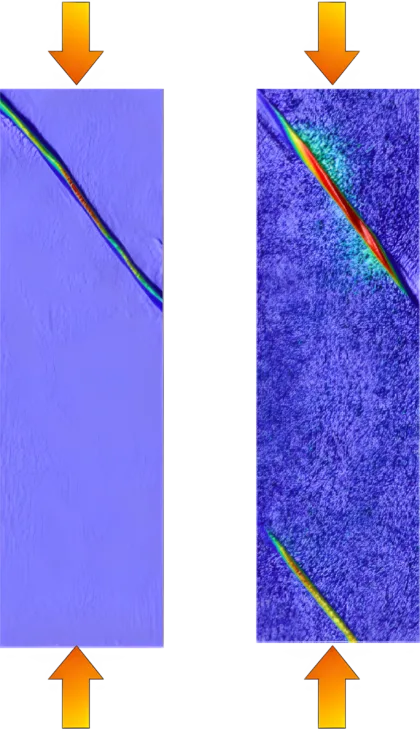
Numerical simulation of shear bands: strain localisation (left), effective pressure (right)
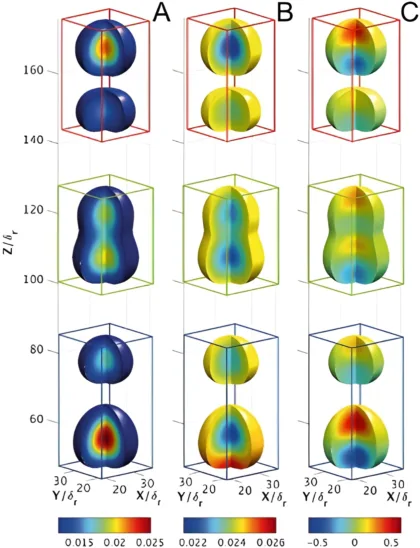
Numerical simulation of pore fluid extraction by reactive solitary waves in 3D, performed at 80 NVIDIA GeForce GTX TITAN X GPUs (Maxwell GM200 architecture) of the Octopus cluster at the University of Lausanne (Switzerland) with spatial discretization of 506 × 506 × 2042 grid points
(Omlin, S., Malvoisin, B., &Podladchikov, Y. Y., Geophys. Research Letters, 2017)
ReactMod performs simultaneous calculations for hundreds of minerals, fluid species, and hydrocarbons, capturing localized effects across the space of possible, non-predefined phases, and providing real-time insights into complex chemical fluid-rock interactions. The complex phase behavior of reservoir fluids and minerals is resolved using the open-system numerical thermodynamic laboratory THERMOLAB, equipped with extended databases of components, aqueous species, and pH for phase equilibrium calculations (Vrijmoed & Podladchikov, Geochem. Geophys. Geosys, 2022; Khakimova et al., Geosciences: Time of Change, Time of Prospects, 2023).
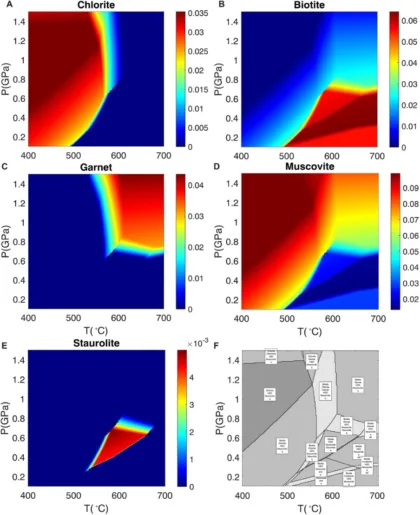
Phase calculations provided with open-system numerical thermodynamic laboratory THERMOLAB: (KFMASH) P-T diagram
(Vrijmoed &Podladchikov, Geochem. Geophys. Geosys, 2022)
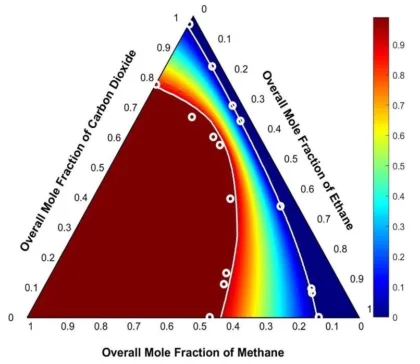
Ternary phase diagram of the methane-ethane-carbon dioxide mixture at 2.53 MPa and 250 K, derived from thermodynamic calculations based on Gibbs energy minimization (Khakimova et al., Geosciences: Time of Change, Time of Prospects, 2023)
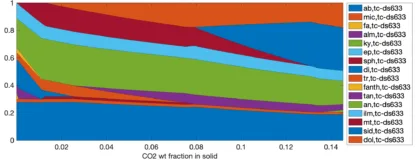
Numerical results obtained using the open-system thermodynamic laboratory THERMOLAB: phase distribution for a system with composition representative of the Deccan Traps (system elements: H-C-O-Na-Mg-Al-Si-K-Ca-Ti-Fe) at 150°C and 1 kbar, presented as a function of CO2 concentration
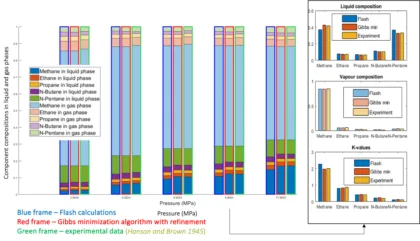
Numerically predicted composition of liquid and gas phases of a five-component hydrocarbon mixture at different pressures: methane, ethane, propane, n-butane, and n-pentane at a temperature of 311 K
(Isaeva, A. V., Dobrozhansky, V. A., Khakimova, L. A., & Podladchikov, Y. Y., Gas Industry, 2021)
ReactMod is based on consistent Hydro-Mechanical-Chemical (HMC) model that seamlessly integrate hydraulic, mechanical, and chemical dynamics at reservoir scale by internal two-way coupling between multicomponent fluid flow, deformations and reactions constrained by thermodynamics and reaction kinetics under gradients (Khakimova & Podladchikov, Petrology, 2024; Schmalholz et al., Geochem. Geophys. Geosys, 2024

Numerical simulation of serpentinite carbonation when H2O–CO2 fluid infiltrates through it, in combination with the viscous deformation of the mineral matrix, with reference to the system MgO–SiO2–H2O–CO2. During continuous H2O−CO2 fluid infiltration with a low concentration of dissolved CO2 (starting with approximately 1 wt %), carbonization of hydrated serpentinite starts and is accompanied by the decomposition of antigorite and crystallization of magnesite and talc.
(Khakimova & Podladchikov, Petrology, 2024)
ReactMod accurately simulates the spontaneous formation of high-permeability leakage pathways in saturated porous media, even under zero-permeability conditions (Yarushina & Podladchikov, Journal of Geophysical Research: Solid Earth, 2015; Räss, L., Simon, N. S., & Podladchikov, Y. Y., Scientific Report 2018; Peshkov, G. A., Khakimova, L. A., Grishko, E. V., Wangen, M., &Yarushina, V. M., Energies, 2021; Alkhimenkov, Y., Khakimova, L., & Podladchikov, Y., Geophysical Research Letters, 2024). This self-consistent approach removes the reliance on predefined system constraints and geometries, delivering unparalleled predictive precision for assessing CO₂ leakage risks during long-term geological storage.
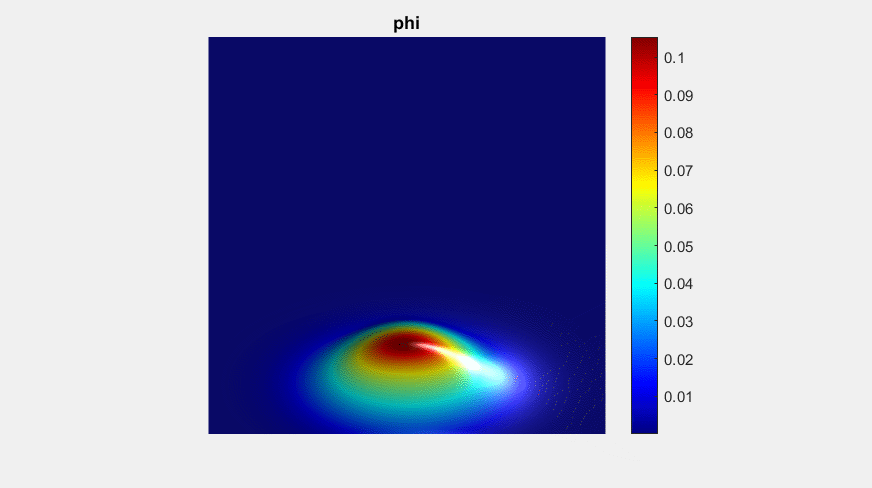
Numerical simulation of channelized solitary porosity waves propagations in deforming, low-permeability, fluid-saturated porous media: porosity evolution (Khakimova, L., Frendak, A., Aranovich, L., & Podladchikov, Y., Copernicus Meetings, 2024)
Numerical simulation of focused fluid flow in deforming saturated rock due to (de)compactions: porosity evolution (left), effectieve pressure (right)
Alkhimenkov, Y., Khakimova, L., Utkin, I., & Podladchikov, Y. (2024). Resolving strain localization in frictional and time‐dependent plasticity: Two‐and three‐dimensional numerical modeling study using graphical processing units (GPUs). Journal of Geophysical Research: Solid Earth, 129(8), e2023JB028566.
Alkhimenkov, Y., & Podladchikov, Y. Y. (2024). Accelerated pseudo-transient method for elastic, viscoelastic, and coupled hydro-mechanical problems with applications. Geoscientific Model Development Discussions, 2024, 1-35.
Alkhimenkov, Y., Khakimova, L., & Podladchikov, Y. (2024). Shear bands triggered by solitary porosity waves in deforming fluid‐saturated porous media. Geophysical Research Letters, 51(15), e2024GL108789.
Beinlich, A., John, T., Vrijmoed, J. C., Tominaga, M., Magna, T., & Podladchikov, Y. Y. (2020). Instantaneous rock transformations in the deep crust driven by reactive fluid flow. Nature Geoscience, 13(4), 307-311.
Isaeva, A. V., Dobrozhansky, V. A., Khakimova, L. A., & Podladchikov, Y. Y. (2021). Numerical simulation of phase equilibria in multicomponent hydrocarbon systems using direct energy minimization. Gas Industry, (2), 20-29
Khakimova, L., Frendak, A.,Aranovich, L., & Podladchikov, Y. (2024). Multicomponent Pore FluidTransport by Hydration Porosity Waves in the Litosphere: A Model forContinental Crust Formation (No. EGU24-14845). Copernicus Meetings.
Khakimova, L. A., Isaeva, A. V., & Podladchikov, Y. Y. (2023). AGibbs Energy Minimization Algorithm for Modeling Phase Equilibrium in Multicomponent Multiphase Mixtures of Hydrocarbons and Reservoir Fluids. In St.Petersburg 2023. Geosciences: Time of Change, Time of Prospects (pp. 411-414).
Khakimova, L., Isaeva, A.,Dobrozhanskiy, V., & Podladchikov, Y. (2021, October). Direct Energy Minimization Algorithm for Numerical Simulation of Carbon Dioxide Injection.Day 3 Thu, October 14, 2021.
Khakimova, L., Frendak, A., Aranovich, L., & Podladchikov, Y. (2024). Multicomponent Pore Fluid Transport by Hydration Porosity Waves in the Litosphere: A Model for Continental Crust Formation (No. EGU24-14845). Copernicus Meetings.
Malvoisin, B., Podladchikov, Y.Y., & Vrijmoed, J. C. (2015). Coupling changes in densities and porosity tofluid pressure variations in reactive porous fluid flow: Local thermodynamicequilibrium. Geochemistry, Geophysics, Geosystems, 16(12), 4362-4387.
Malvoisin, B., Brantut, N., &Kaczmarek, M. A. (2017). Control of serpentinisation rate by reaction-induced cracking. Earth and Planetary Science Letters, 476, 143-152.
Malvoisin, B., Podladchikov, Y.Y., & Myasnikov, A. V. (2021). Achieving complete reaction while the solid volume increases: A numerical model applied to serpentinisation. Earth andPlanetary Science Letters, 563, 116859.
Omlin, S., Malvoisin, B., &Podladchikov, Y. Y. (2017). Pore fluid extraction by reactive solitary waves in3‐D. Geophysical Research Letters, 44(18), 9267-9275.
Peshkov, G. A., Khakimova, L. A., Grishko, E. V., Wangen, M., &Yarushina, V. M. (2021). Coupled basin and hydro-mechanical modeling of gaschimney formation: The SW Barents Sea. Energies, 14(19),6345.
Räss, L., Simon, N. S., & Podladchikov, Y. Y. (2018). Spontaneous formation of fluid escape pipes from subsurface reservoirs. Scientific reports, 8(1), 11116.
Räss, L., Utkin, I., Duretz, T., Omlin, S., & Podladchikov, Y. Y.(2022). Assessing the robustness and scalability of the acceleratedpseudo-transient method. Geoscientific Model Development, 15(14), 5757-5786.
Schmalholz, S. M., Khakimova, L.,Podladchikov, Y., Bras, E., Yamato, P., & John, T. (2024). (De) hydrationFront Propagation Into Zero‐Permeability Rock. Geochemistry, Geophysics, Geosystems, 25(9), e2023GC011422.
Vrijmoed, J. C., & Podladchikov, Y. Y. (2022). Thermolab: A thermodynamics laboratory for nonlinear transport processes in open systems.Geochemistry, Geophysics, Geosystems, 23(4), e2021GC010303.
Yarushina, V. M., & Podladchikov, Y. Y. (2015). (De) compaction of porous viscoelastoplastic media: Model formulation. Journal of Geophysical Research: Solid Earth, 120(6), 4146-4170.
Yarushina, V. M., Podladchikov, Y. Y., & Wang, H. (2023). On theconstitutive equations for coupled flow, chemical reaction, and deformation ofporous media. Journal of Geophysical Research: Solid Earth, 128(12),e2023JB027725.
Copyright © 2024 Geo Modelling HPC Solutions AG